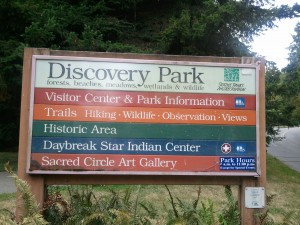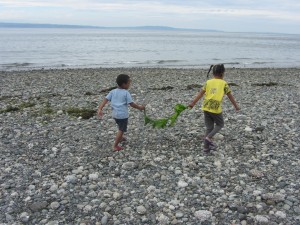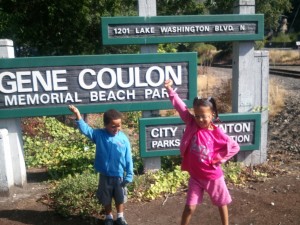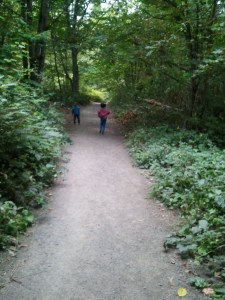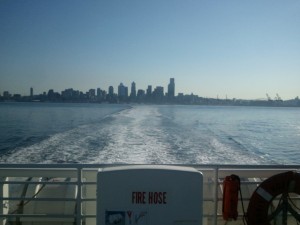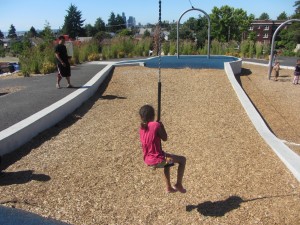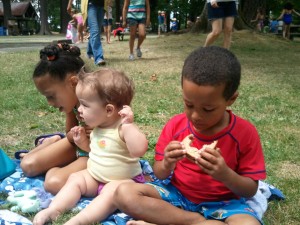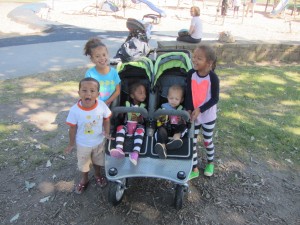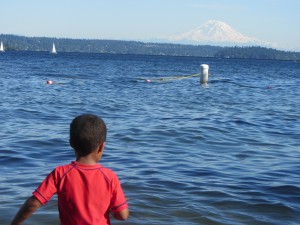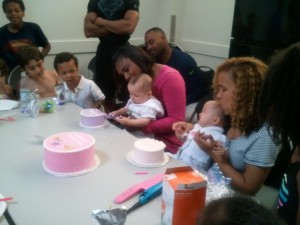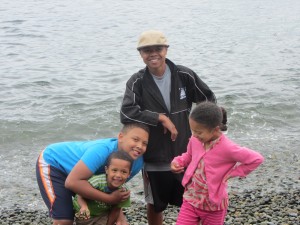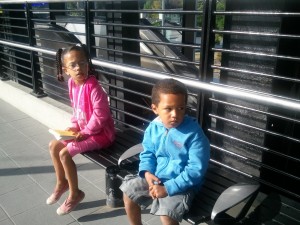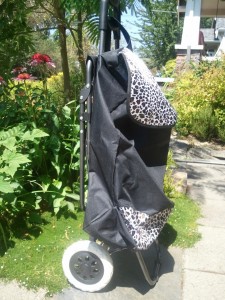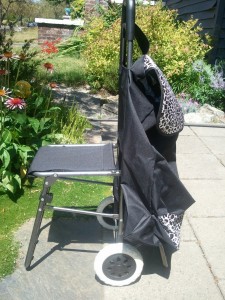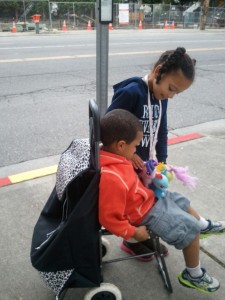I have a tendency to write about our family’s extreme adventures. I write about how we ride the bus to Coulon Park or the Puyallup Fair or Yakima, about the three-bus trip with my toddler and week-old baby (in January) to my Goddaughter’s first birthday party, about many of the ridiculous things we’ve transported on the transit.
I’m not sure why I focus on this stuff. I think it’s partly because I’m a bit of an extremist. If I’m not careful, I can drift into the literal, rigid, all-or-nothing mindset of my second grader. (Who am I kidding? She’s a chip off the big chick.) But mostly, I think it’s because the extreme tends to be more interesting and memorable than the mundane. I doesn’t (usually) occur to me to write about our daily walks to school, or our 48 rides to church (which are much less awesome since our stop was removed—ahem), or our uneventful 8 rides* to the dentist in Columbia City.
Our extreme adventures might be useful for entertainment value (emphasis on the might), but they’re not especially good at inspiring folks to action. In my experience, taking small steps, if they go well, leads to taking larger steps, and before you know it, you’ve spun yourself a big, beautiful bus ridin’ positive feedback loop. I, for example, started my journey to completely insane bus fanatic with a simple decision to use my free bus pass from work once in a while. Actually, my journey officially began when I started riding Metro to school at eight years old. But I digress.
The point is, despite my impatience with the concept of incremental change (and the fact that we’ve long since passed the window for baby steps), I understand that it is only possible to move people when you meet them where they are. Or when you become a dictator. (The dictator thing could really come in handy in other ways, like for making sure there’s frequent and reliable transit for people who are willing to use it. Sadly, I don’t have the charisma — or soldiers — to pull it off.)
Though I don’t have many of the skills necessary for effecting change, I do have many years of experience getting around without a car. The least I can do is provide some reasonable, achievable advice to help people drive less. So, in order of difficulty, here’s a (short) list of things you can do to spend less time in your car.
1. Take transit every time you go downtown for non-work trips.
This is a no brainer. Driving downtown is stressful. It’s difficult and expensive to park, and there’s almost always too much traffic on the way in and on the way out. On the flip side, most neighborhoods, even neighborhoods where transit is scarce, offer decent, direct service to downtown. Save yourself hassle and money, and just do it.
2. For optional, leisure trips that are a mile or less, walk or ride your bike.
Spring is almost here, and being outside is good for your body and soul. If you’re going somewhere just for the fun of it, make getting there part of the fun. Chances are you’ll see neighbors you don’t often have the chance to talk to. You might pass a business you’d like to visit. And, I can guarantee you’ll see something you never knew was there. (A few Sundays ago, we took a different route home from church and discovered a house with a giant goldfish pond in the yard.)
Ideally, the walk/bike zone should be two miles for able-bodied people, but I’m starting small because I want these tips to be achievable. Walking two miles (really four, since any trip is there and back) is a decent time commitment, and biking with a family presents complexities. If the kids are very small, special equipment is required. If they are old enough to ride their own bikes but not old enough to ride in traffic, it can be challenging to find a route. (Sidewalks are not ideal for groups of people on bicycles.)
That said, if you have the time to invest in a longer walk, you don’t have kids, or you’re willing to figure out how to make bicycling work for your family, make two miles your goal and give yourself a gold star.
3. Do more in your own neighborhood.
One of the reasons people drive so much is because our culture teaches us to search out “the best” of everything: the grocery store with the most selection, the absolute best swim lessons, the tastiest burger. Don’t get me wrong. I’m not saying we shouldn’t explore. (My family loves exploring.) I’m saying that all this searching for more and better has caused us to forget that there’s such a thing as good enough. And, it has kept us from being fully connected to the communities we call home.
What if you made a commitment to appreciate what’s in your neighborhood (including your actual neighbors, by the way) more often, instead of constantly looking elsewhere? The more reasons you have to participate in your own community, the more you can take advantage of tip #2.
4. Change how your kids get to school.
When you’re crunched for time and have more than one stop to make, driving feels like a necessity. Parents who have to ensure that their kids get to and from school or daycare often drive daily because it is simpler than trying to figure out how to manage multiple stops using a different mode. But what if you thought about your commute and your child’s as two separate trips? Chances are you have options.
If you have school-age children there’s a decent chance there’s a school bus available for them to ride. (In Seattle, kids are required to attend neighborhood schools, so this isn’t the case for most elementary students.) If you live too close for a school bus, find out if there’s a “walking school bus” (a volunteer-led, group walk) in your community. If not, consider organizing one. Or, try walking with them. If they are old enough, consider letting them walk or bike to school on their own or with friends.
The best part is, changing how your kids get to school can sometimes expand the options you have for getting to work. If your kids can get to school without you (by school bus, walking school bus, or walking or biking alone), you can then reconsider how you get to work. Even if you are walking with them (or for that, matter, driving them), you can plan your commute starting from their school. Is there a bus that stops nearby? Do you have coworkers you can carpool with? Can you bike with them to school and then bike from their school to work?
The key is to separate the trips and figure out what the options are for each. It might not be as difficult as you think.
Happy (almost) spring, everyone. Hope to see you out there!
***
*Starting on March 26th, the ride to Columbia City will require a transfer, which will necessarily make it more eventful. But hey.

